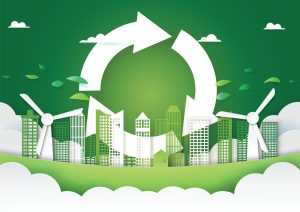Innovative Architects Reclaiming Spaces: Creative Reutilization
Reduce. Recycle. Reuse.
 Follow us on our series ‘Let’s Talk Recycling.’ Recycling is a large part of a sustainable future and something we can all take part in as a community.
Follow us on our series ‘Let’s Talk Recycling.’ Recycling is a large part of a sustainable future and something we can all take part in as a community.
Buildings, buildings, buildings everywhere. The construction industry is booming in the U.S. with an expected output to exceed $1,735,526.5 million by 2027. Home construction in the nation is the highest in three decades. Commercial property construction was up by 41.6% in 2022.
Historic preservation projects sustain the existing form, integrity, and materials of cultural significance. The overall goal of historic preservation is to protect and maintain archaeological structures. An example of historic preservation is the Eleanor Roosevelt School in Meriwether County involving a new roof, restoration of windows, doors, and full rehabilitation of the interior spaces including historical pictures. With the kickoff ceremony September 7, 2023, The Georgia Trust for Historic Preservation will be in partnership with owners, Debron and Voncher Walker, using funds awarded through the National Park Service Historic Preservation Fund’s African American Civil Rights grant. The building will be maintained for historical heritage relevance and education. But, what happens to abandoned buildings that are not considered historically relevant for preservation and are deteriorating?
Creative reutilization or creative reuse of existing buildings is the future of architecture. Creative reutilization is a popular eco-friendly design breathing new life into abandoned structures while retaining the city’s previous lives and histories. Adapting structures that have outlived their purpose or usefulness helps to preserve the heritage of a community while creating a new zone with purpose. Just a few Atlanta creative reutilization projects include Campus 244, Midtown ‘12th & Everything’, 1050 Brickworks, and Creative Village. The benefits of creative reutilization to society and environmental sustainability are invaluable. It slows urban sprawl, unrestricted expansion in urban areas, and offers a clever counter. Reutilization of an existing structure will reduce the need for new materials. The adaptation design lowers construction cost, removes need for demolition, low-time consumption process (adapting is much faster than building a new structure), supports a more sustainable process, and helps to preserve the existing fabric and history of the community. Deborah Berke, Dean at Yale School of Architecture, and author of Transform: Promising Places, Second Chances, and the Architecture of Transformational Change, sees recycling existing buildings as an opportunity for cities to engage with historical trauma, encourage cultural continuity and move beyond generic expectations of what older structures can become in a rapidly changing world.
The reutilization of existing buildings is becoming increasingly crucial with the global effects of climate change. Adaptive architecture helps reduce embodied carbon used when building a new structure. An existing building will reduce operational carbon emissions and reduce energy consumption. With a projected 80% of buildings existing in 2050 already constructed, changing, and morphing a previously used structure will allow for a more powerful use of an architect’s artistic license. Creating a sustainable future during the process will help reach net-zero emissions by mid-century and be its own historical architectural footprint. Creative reutilization of structures benefits our future. Reutilizing and being a LEED, Leadership in Energy and Environmental Design, certified building addresses climate change and meets ESG goals, enhancing resilience, and supporting more equitable communities. Check out some of the most creative reutilized buildings rated LEED certified here.




